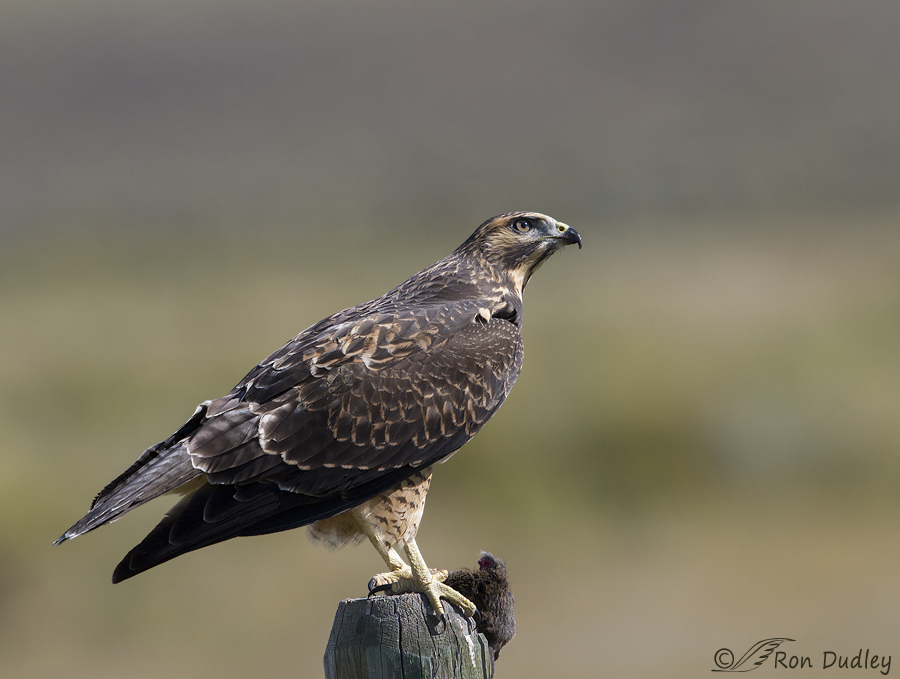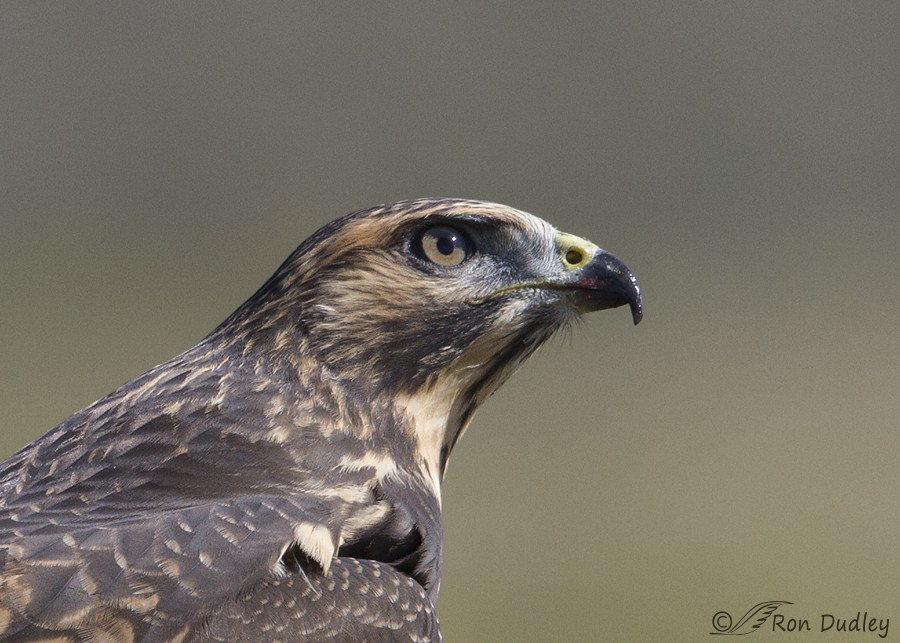Normally when I’m photographing birds I pack it in when the sun gets too high in the sky because light becomes harsh and contrasty, shadows extreme and catch lights more difficult to get. I sometimes photograph later in the day during winter when the sun stays so much lower in the sky but in summer I tend to quit about 10 am. Since I’m typically out there at dawn, by then I’ve had quite a few hours of shooting. And with raptors in particular there’s an additional reason for photographing when the sun is low in the sky – it’s called the brow ridge.
Sometimes when I’m on camping trips I push the limits of light angle and time by shooting later in the day and take my chances because bird photography is the main reason I’m there and it may be months before I’m in the area again. That’s exactly what happened with this adult Swainson’s Hawk in Montana’s Centennial Valley nine days ago.

1/1600, f/6.3. ISO 500, Canon 7D, Canon EF500mm f/4L IS II USM, not baited, set up or called in
This hawk was close, it had prey and I liked the background (though the image is a little tight at bottom). But it was 10:52 in the morning so the light was harsh which is particularly noticeable in the deep shadows of the wing primaries and the brights on the front of the lower legs. In processing I brought those brights down as much as I reasonably could but they’re still not ideal.
But the biggest problem I had with this bird was trying to get a catch light. I took quite a few photos of the hawk but because the sun was so high in the sky the eye was shaded and in most of those shots there was no light in the eye when the bird was looking my way so I deleted them. The only thing that saved me with this image was the fact that the hawk momentarily looked up into the sky at another bird which provided a proper angle for some light in the eye.
This is even a bigger problem with raptors than it is with other species because of their brow ridge above the eye.

Raptors have a heavy, bony ridge above the eye called the brow ridge that helps to protect their eye from injury, especially when they go after prey in brush or other vegetation. It also acts as a built-in baseball cap since it helps to shade their eyes from the sun and that’s exactly what often prevents catch lights in photographs taken during mid-day. The brow ridge is also what gives raptors that scowling expression that makes them look so fierce.
If you look closely at this highly cropped version of the previous image you’ll see that I came very close to not getting a catch light, even with the head tilted toward the sun. Because of the brow ridge the upper part of the relatively flat iris inside the eye is shaded but due to the convex bulge on the shiny cornea on the outside of the eye where the catch light is produced the cornea still had light on it (barely) so I got the sun’s reflection. Without the head-tilt I likely wouldn’t have.
In previous posts I’ve covered the importance of catch lights in bird photography. Without them, viewers perceive the eye to be flat and lifeless. Most serious bird photographers typically delete bird images without light in the eye, as do I unless the image demonstrates some interesting behavior or there’s some other reason to keep the photo.
All this may be much ado about nothing for some but it’s of primary importance to bird photographers…
Ron
Note: It was a question about catch lights in the comments on this post from Jorge H. Oliveira that prompted me to do a post on this subject. Thanks, Jorge!


Ron – I love your description of the effect of catch light, as well as your wonderful examples from the earlier post. As a photographer, I certainly prefer images with catch light, but am sometimes forced to accept those without it–typically because I simply wasn’t able to capture it in a particular bird, and I don’t have the heart to delete the image (either because it’s a rare bird, it’s the only photo I have of a particular species, or the photo is, in all other ways, perfect). This is the struggle we all face, it seems.
Thanks again!
Beautiful picture Ron. It’s funny how just a spot of light can add to a picture.
Fabulous shots Ron, thanks for sharing!
Charlotte
Very informative, and, as usual, some good chuckles from the comments. I join with Elephant’s Child in anticipating the evil iPad’s antics. (Sorry, Patty, I do know how frustrating it is for you.)
Thank you, Susan.
Education and beauty keep me coming back. And wondering what the Evil iPad will do today… Thank you one and all.
That thing has a personality, doesn’t it, Elephant’s Child?
Not a personality but a poisonality. And I do feel for Patty. And have only my dyslexic fingers to blame for my own errors.
I enjoyed this a great deal. Thank you for the lesson!
You’re very welcome, Arwen.
I am glad that my curiosity led you to write a post on this subject and I am grateful to you to have the opportunity to learn some more about it.
Thank you Ron.
The thanks go to you, Jorge. I appreciate the inspiration.
Your articles are so informative. Every time I read your post I get to know something more about Photography. The rules of Bird Photography can be applied to other fields of this art. Your patience to create a good photograph and your knowledge and the willingness to share that is a huge bonus for your readers. Thank you very much Ron!
What you said means a lot to me, Rima. Thank you.
That should read “incorporating the rictals”. The Evil iPad is still at it…That it hates me is obvious…my latest effort at retaliation has been to ignore what it does, to not give it the satisfaction of a response…but, sometimes it’s just too much!….
I fixed it Patty but I’m leaving your last comment because your Evil iPad has become so much of an endearing fixture for some of us around here…
And incorporating the rictals!
Good points, Patty. You have a fine eye for detail!
I think that equally important, when photographing or painting a raptor, is capturing the shadow of the brow ridge across the top of the eye…
Hi! Beautiful colors and bird! Keep up your great work! Have a wonderful day!
Thank you, Humming Bird Lover.
Wonderful description of “Catch Light” and how important it is in bird photography.
Unfortunately many of us catch a shot of a bird when we can and deal with the problems of harsh light.
That is why I end up deleting many of my shots, when I get around to it.
Many thanks for sharing your information and experience, it is much appreciated from this viewer!
Dick, It’s a very good thing that I’m naturally an “early bird” and enjoy my mornings so much. If I were a late sleeper (or if I were still working), catch lights would be an even larger problem for me but even so I still delete about 90% of my images and many times it’s because of a lack of light in the eye. Thanks very much.
You not only caught the catch light, but the ” glass dome” effect of the iris under the cornea…as a wildlife painter, I also appreciate the “direction of growth” details…Ex. The backward sweep of the outer feathers of the brow and the out and upward sweep of the small feathers of the cheek. Not onlly important is the catch light on the eye, but I also like the bright highlight on the front edge of the bird’s beak. It is equally important when painting a bird or other living creature, to include the catch light…I always get a little rush of pleasure when I put it in, because then my painting suddenly “comes to life”…without it, it’s flat….
I always enjoy your artist’s perspective when you provide it, Patty. Thank you.
I appreciate Patty’s perspective as well. Ron, this is a great, short tutorial. I know that even with the sun low, it can be difficult to avoid that shadow, depending on where you are in relation to the bird. I was having that issue with a Burrowing Owl in California, and had few options of where to place myself and at what hour to photograph. It all makes such a huge difference. Beautiful image and bird here!
Thank you, Ingrid.
“(I) had few options of where to place myself and at what hour to photograph”. Isn’t that so very often the case, Ingrid? Just two of the many factors that make bird photography so challenging. But then if it were easy it wouldn’t be as much fun when we succeed…